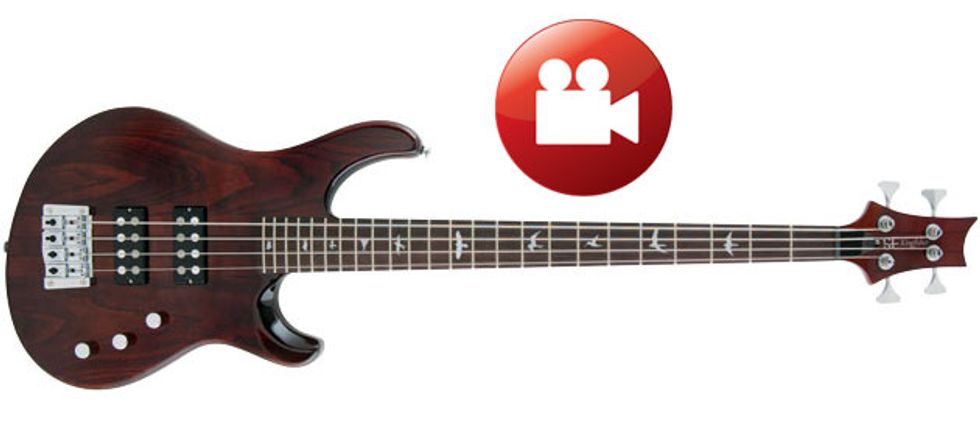
Ready yourselves bassists: Paul Reed Smith has his sights set on you. The company has recently diversified their bass lines to suit the needs and wallets of a wider variety of players. The seed was planted last year with the release of the Grainger series, lauded for its build quality and beefy modern tone. Seeking similar praise from the more budget-friendly crowd, PRS augmented their 2014 SE line by introducing the Kestrel and Kingfisher basses. While the Kestrel takes on a more classic approach, the Kingfisher we just checked out comes closest to capturing the characteristics of Paul Reed Smith’s boutique offerings.
Flight of the Kingfisher
It’s always a positive sign when you unbox an import instrument and find it protected in a high-quality gigbag. Unsheathing the test bass revealed characteristic PRS quality, though a few mild scratches in the body finish were present. After a quick setup, the Kingfisher was ready to play.
Much like its Grainger 4 cousin, the Kingfisher shares impressive balance while playing seated or standing with the bass strapped on. Never did it cause any shoulder fatigue when I was standing. The bass provided unhindered movement of my fretting hand and felt smooth despite its glossy neck. There was very little to no stickiness to impede left-hand shifting.
SE Anatomy
A highlight of the Kingfisher is its neck-through construction, a rarity for instruments under the $800 price point. Its 5-ply maple-and-walnut neck supports a rosewood fretboard that’s decorated with the company’s classic bird inlays. While every player has a particular preference for neck contours, PRS seems to have a magic formula for playability and the Kingfisher is no exception. It has a smooth taper and a comfy radius from the first flying fowl to the perched bird, and I acclimated to the fretboard rather quickly.
Flanking the neck are swamp-ash body wings, carved in a shape reminiscent of the Grainger’s body. The tortoiseshell finish of our tester gives the instrument a walnut-like disguise with a rich look that delivers understated elegance. Natural and scarlet-red finishes are also available.
Simplicity is key to the SE Kingfisher’s electronics. PRS employs a pair of proprietary humbucking pickups for the bridge and neck positions, and the passive control system consists of a volume/volume/tone configuration.
Hipshot hardware keeps the strings secure and in tune. The HB6 tuners offer smooth gear movement and stable positioning, and add little weight to the head. PRS outfitted the Kingfisher with a convertible TransTone bridge that allows top loading the strings or running them through the body.
Stage Sounds
Tonally, the Kingfisher’s voice has a present, glassy top end, mids that respond to articulations, and tight lows. Players who like the sound of G&L basses, Ken Smiths, and, of course, the PRS Grainger, will most likely be pleased with the Kingfisher’s timbre.
Ratings
Pros:
A simple, great-looking bass that can establish a solid sonic footprint.
Cons:
Slight finish flaws on test model. Tone may not appeal to fans of old-school sound.
Tones:
Playability:
Build/Design:
Value:
Street:
$799
PRS SE Kingfisher
prsguitars.com
For live settings, I tested the Kingfisher through two different rigs—a Schertler Bass Fidelity 1x10 combo and an Epifani UL 501 head paired with an Epifani 4x10. The strongest sonic aspect of the bass is the way in which it sits in the mix. For example: When the Kingfisher was paired with the Epifani rig for a rock-covers show with a vocals-only PA, the bass contended quite well with two guitarists wielding Fender Super Reverbs and a heavy hitting drummer. The bass notes on the 1st string disappeared occasionally, but soloing the bridge pickup and a boost in the amp’s mids brought a snarl that ripped through the band.
I ran the Kingfisher through the Schertler combo on a jazz trio gig, where I featured the neck pickup and a slight roll-off of the tone control. The bass didn’t deliver a P-style tone, or even an upright-like sound, but more of a deep, punchy voice that supported the trio’s foundation. This tone would also fit quite well in a salsa band. On both gigs, the Kingfisher’s comfortable design continued to impress with a very pleasing experience for my hands and back.
The most positive comments I received came when I used the Kingfisher in the studio for a commercial session. Despite some slight fret buzzing, the tone impressed the engineer. He said it made his job easier since he only had to add a touch of compression and very little EQ. In fact, when I left the studio, he asked me to bring the bass back and play it on my next session. If a particular bass can help you stay employed, it’s probably a good idea to keep it in your arsenal.
The Verdict
The Kingfisher is a solid addition to the PRS aviary. Players who have been curious about PRS basses can now get a taste of their sound and style without having to spend a ton of coin. Yes, there is a lot of competition at the Kingfisher’s price point, but the neck-through design and signature features really make it stand out from the crowd. Whether you’re a beginner, an amateur looking to upgrade, or a road dog in need of a modern workhorse, the PRS SE Kingfisher is certainly worth a test flight.
Watch the Review Demo:





![Rig Rundown: AFI [2025]](https://www.premierguitar.com/media-library/youtube.jpg?id=62064741&width=1245&height=700&quality=70&coordinates=0%2C0%2C0%2C0)












 Shop Scott's Rig
Shop Scott's Rig















































